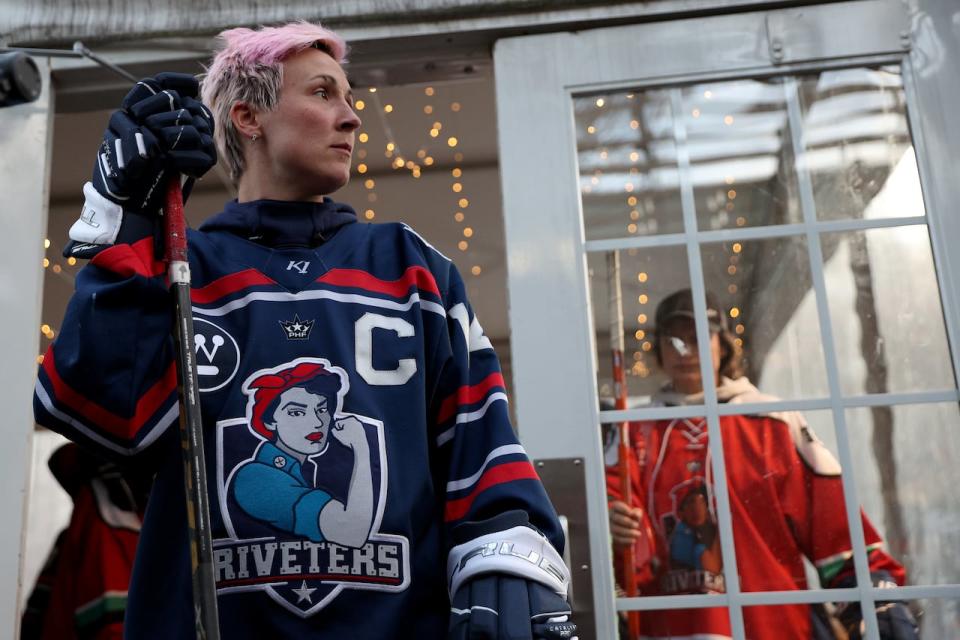The Canadian Press
Thu, July 6, 2023

COLUMBUS, Ohio (AP) — Groups hoping to enshrine abortion rights in Ohio’s constitution delivered nearly double the number of signatures needed to place an amendment on the statewide ballot this fall, aiming to signal sweeping widespread support for an issue that still faces the threat of needing a significantly increased victory margin.
Ohioans United for Reproductive Rights said they dropped off more than 700,000 petition signatures on Wednesday to Republican Ohio Secretary of State Frank LaRose's office in downtown Columbus. LaRose now will work with local election boards to determine that at least 413,446 signatures are valid, which would get the proposal onto the Nov. 7 ballot.
"Today, we take a huge step forward in the fight for abortion access and reproductive freedom for all, to ensure that Ohioans and their families can make their own health care decisions without government interference,” Lauren Blauvelt and Kellie Copeland of Ohioans for Reproductive Freedom, a coalition member, said in a statement.
At a news conference, Copeland said the 422 boxes delivered "are filled with hope and love and dreams of freedom, of bodily autonomy, of health, of being able to say, ‘We decide what happens to us.’ ”
The ballot measure calls for the establishment of “a fundamental right to reproductive freedom” with “reasonable limits.” In language similar to a constitutional amendment that Michigan voters approved in November, it would require restrictions imposed past a fetus’ viability outside the womb, which is typically around the 24th week of pregnancy and was the standard under Roe v. Wade, to be based on evidence of patient health and safety benefits.
The state's formidable anti-abortion network has vowed a dogged and well-funded opposition campaign, which could take the price tag for the fight above $70 million.
Protect Women Ohio, the opposition campaign, downplayed the huge number of signatures submitted, saying they were collected with help from paid signature-gatherers funded in part of the American Civil Liberties Union, which it described as “anti-parent.” Abortion foes contend that the Ohio amendment has the potential to trump the state's abortion-related parental consent law, though the lawyers who wrote it deny the claim.
"The ACLU’s attempts to hijack Ohio’s constitution to further its own radical agenda would be pathetic if they weren’t so dangerous,” campaign press secretary Amy Natoce said in a statement.
Two legal challenges have gone proponents' way.
The first was a decision by the Ohio Supreme Court that allowed the measure to proceed as a single issue, rather than as two questions that would have required twice as many signatures. Justices found that the proposed amendment’s call to protect individuals' rights to make their own decisions about a continuum of reproductive care issues — contraception, fertility treatment, continuing one’s pregnancy, miscarriage care and abortion — met the standard of applying to the “same general purpose.”
In a second ruling, the court denied Republican Attorney General Dave Yost’s request that justices launch a review of the right to an abortion under the Ohio Constitution, leaving those arguments to play out in a lower court and keeping alive the purpose of the proposed amendment.
But the ruling that might have the biggest impact favored abortion opponents. It allowed an August special election to proceed that will seek to raise the threshold for passing future amendments — including as soon as November — from a 50%-plus-one simple majority that has been in place since 1912 to a 60% majority. Abortion rights amendments in other states have tended to pass with more than 55% but less than 60% of the vote.
The outcome of that August election would not affect a recreational marijuana question for which supporters submitted more than 222,000 signatures later Wednesday.
The Coalition to Regulate Marijuana Like Alcohol is pursuing ballot access for its proposal to legalize marijuana for adult use after the Republican-controlled Legislature failed to act on its initiated statute, which now requires roughly 124,000 valid signatures to make the ballot. The threshold for passing such measures would not be changed by the amendment being voted on in August.
The legal cannabis measure would appear alongside an Ohio abortion rights effort prompted by last summer's U.S. Supreme Court decision to overturn Roe v. Wade and the nationwide right to abortion and instead leaving it to states to decide for themselves.
In the first statewide test following that decision, Kansas voters resoundingly protected abortion rights last August. Meanwhile, four other states in addition to Michigan — California, Kentucky, Montana and Vermont — either enshrined abortion rights or rejected constitutional restrictions on the procedure in November.
Julie Carr Smyth, The Associated Press











